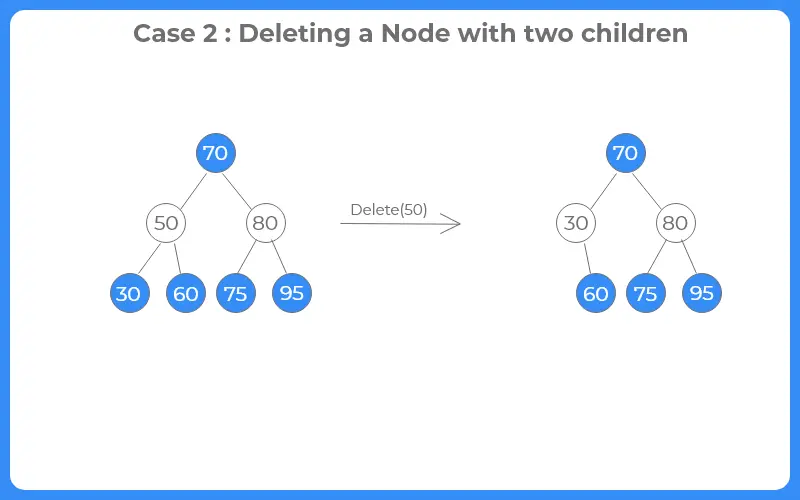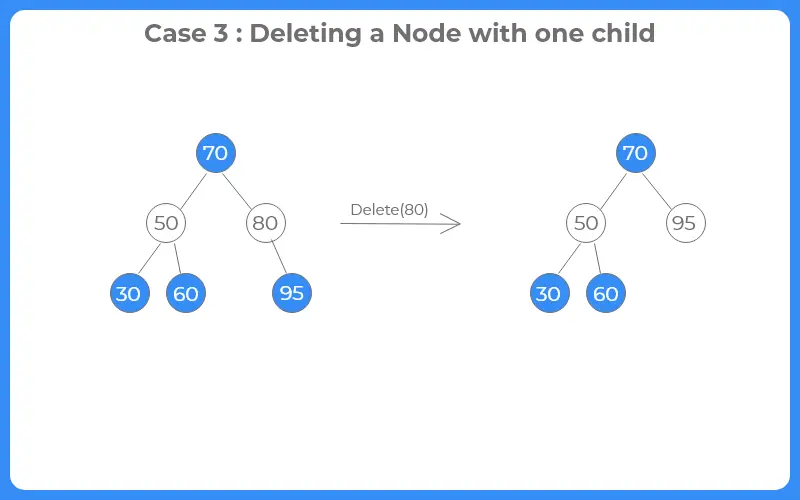Binary Search Tree: Deletion
Deletion In Binary Search Tree
A Binary Search Tree is a rooted binary tree whose internal nodes each a key greater than all the keys in the node’s left subtree and less than those in it’s right subtree. Delete function is used to delete the specified node from binary search tree. In this article we will perform deletion in binary search tree.

Deletion in a Binary Search Tree In C
- Deletion in a Binary Search Tree has three possible ways of removal or elimination of a node.
- It is important to keep in mind the property that serves as the foundation of a BST structure.
- A tree is said to be a BST only if,
node(left_subtree) < root node < node(right_subtree).
- Even when deleting a node from a BST, we should not disturb this important aspect of it.
- Let us see the three possible ways in which a node can be deleted from a binary search tree.
The three possible cases in which we are supposed to delete any element from a binary search tree are:
- The node to be deleted has no child nodes.
- The node to be deleted has one child.
- The node to be deleted has two child nodes.
Case 1: Deleting a node with no children :-
If the node to be deleted from the tree has no child nodes, the node is simple deleted from the tree since it is a leaf node.
Case 2: Deleting a node with two children :-
we first find the inorder predecessor of the node and replace the target node with the inorder predecessor.
Case 3: Deleting a node with one child :-
If the node to be deleted has a single child node, the target node is replaced from its child node and then the target node is simply deleted.
Implementation of Deletion In BST
Run
#include <stdio.h>
#include <stdlib.h>
struct node
{
int data;
struct node *left, *right;
};
struct node *newNode (int value)
{
struct node *temp = (struct node *) malloc (sizeof (struct node));
temp->data = value;
temp->left = temp->right = NULL;
return temp;
}
void inorderTraversal (struct node *root)
{
if (root != NULL)
{
inorderTraversal (root->left);
printf ("%d ", root->data);
inorderTraversal (root->right);
}
}
struct node *deleteNode (struct node *root, int key)
{
if (root == NULL)
return root;
if (key < root->data)
{
root->left = deleteNode (root->left, key);
}
else if (key > root->data)
{
root->right = deleteNode (root->right, key);
}
else
{
if (root->left == NULL)
{
struct node *temp = root->right;
free (root);
return temp;
}
else if (root->right == NULL)
{
struct node *temp = root->left;
free (root);
return temp;
}
struct node *temp = root->right;
while (temp->left != NULL)
{
temp = temp->left;
}
root->data = temp->data;
root->right = deleteNode (root->right, temp->data);
}
return root;
}
int main ()
{
struct node *root = newNode (50);
root->left = newNode (30);
root->right = newNode (70);
root->left->left = newNode (20);
root->left->right = newNode (40);
root->right->left = newNode (60);
root->right->right = newNode (80);
printf ("Inorder traversal of the original tree: ");
inorderTraversal (root);
int key = 50;
root = deleteNode (root, key);
printf ("\nInorder traversal after deleting %d: ", key);
inorderTraversal (root);
return 0;
}
Output:
Inorder traversal of the original tree: 20 30 40 50 60 70 80 Inorder traversal after deleting 50: 20 30 40 60 70 80
Prime Course Trailer
Related Banners
Get PrepInsta Prime & get Access to all 200+ courses offered by PrepInsta in One Subscription
Get over 200+ course One Subscription
Courses like AI/ML, Cloud Computing, Ethical Hacking, C, C++, Java, Python, DSA (All Languages), Competitive Coding (All Languages), TCS, Infosys, Wipro, Amazon, DBMS, SQL and others
Introduction to Trees
Binary Trees
- Binary Tree in Data Structures (Introduction)
- Tree Traversals: Inorder Postorder Preorder : C | C++ | Java
- Inorder Postorder PreOrder Traversals Examples
- Tree Traversal without Recursion
Binary Search Trees
Traversals
- Traversal in Trees
- Tree Traversals: Breadth-First Search (BFS) : C | C++ | Java
- Tree Traversals: Depth First Search (DFS) : C | C++ | Java
- Construct a Binary Tree from Postorder and Inorder
B – Trees
AVL Trees
- AVL Trees
Complete Programs for Trees
- Depth First Traversals – C | C++ | Java
- Level Order Traversal – C | C++ | Java
- Construct Tree from given Inorder and Preorder traversals – C | C++ | Java
- Construct Tree from given Postorder and Inorder traversals – C | C++ | Java
- Construct Tree from given Postorder and Preorder traversal – C | C++ | Java
- Find size of the Binary tree – C | C++ | Java
- Find the height of binary tree – C | C++ | Java
- Find maximum in binary tree – C | C++ | Java
- Check whether two tree are identical- C| C++| Java
- Spiral Order traversal of Tree- C | C++| Java
- Level Order Traversal Line by Line – C | C++| Java
- Hand shaking lemma and some Impotant Tree Properties.
- Check If binary tree if Foldable or not.- C| C++| Java
- check whether tree is Symmetric – C| C++| Java.
- Check for Children-Sum in Binary Tree- C|C++| Java
- Sum of all nodes in Binary Tree- C | C++ | Java
- Lowest Common Ancestor in Binary Tree- C | C++ | Java
Introduction to Trees
Binary Trees
- Binary Tree in Data Structures (Introduction)
- Tree Traversals: Inorder Postorder Preorder : C | C++ | Java
- Inorder Postorder PreOrder Traversals Examples
- Tree Traversal without Recursion
Binary Search Trees
Traversals
- Traversal in Trees
- Tree Traversals: Breadth-First Search (BFS) : C | C++ | Java
- Tree Traversals: Depth First Search (DFS) : C | C++ | Java
- Construct a Binary Tree from Postorder and Inorder
B – Trees
AVL Trees
- AVL Trees
Complete Programs for Trees
- Depth First Traversals – C | C++ | Java
- Level Order Traversal – C | C++ | Java
- Construct Tree from given Inorder and Preorder traversals – C | C++ | Java
- Construct Tree from given Postorder and Inorder traversals – C | C++ | Java
- Construct Tree from given Postorder and Preorder traversal – C | C++ | Java
- Find size of the Binary tree – C | C++ | Java
- Find the height of binary tree – C | C++ | Java
- Find maximum in binary tree – C | C++ | Java
- Check whether two tree are identical- C| C++| Java
- Spiral Order traversal of Tree- C | C++| Java
- Level Order Traversal LIne by Line – C | C++| Java
- Hand shaking lemma and some Impotant Tree Properties.
- Check If binary tree if Foldable or not.- C| C++| Java
- check whether tree is Symmetric C| C++| Java.
- Check for Children-Sum in Binary Tree- C|C++| Java
- Sum of all nodes in Binary Tree- C | C++ | Java
- Lowest Common Ancestor in Binary Tree. C | C++ | Java






Please explain the below snippet of code
else
{
p1=ptr->right;
p2=ptr->right;
while(p1->left != NULL)
p1=p1->left;
p1->left=ptr->left;
free(ptr);
return p2;
}
Can u explain above code?
Hey Sneka, may i know what part you didn’t understood
Can u explain the delete function?
In the delete function we are checking the three conditions which are mentioned above on the page.
That is, whether the node has child nodes or not
if it does not have any child nodes, then it is just simply removed from the tree
if it has child nodes, then we will check that whether it has one child node or two child node
if it has one child node, then the particular node is deleted and the child node data is replaced with that node
if it has two child nodes, than the particular data is deleted, and the right child node becomes the parent node, and the left child node
now has a new parent node.
I hope this helps you in understanding the code